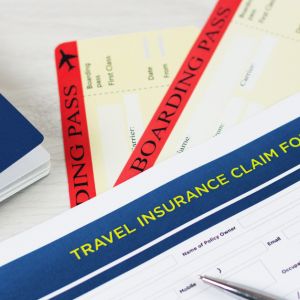Welcome to the world of travel insurance forms! Travel insurance forms are essential documents that play a crucial role in ensuring you have the necessary coverage and protection during your travels. In this article, we’ll explore the importance of travel insurance forms, the different types available, and provide valuable tips for completing them accurately. Understanding travel insurance forms is vital for travelers seeking comprehensive coverage and peace of mind while exploring the world. Let’s delve into the details of travel insurance forms and learn how to navigate them effectively.
Introduction to Travel Insurance Forms

Travel insurance forms serve as the foundation for securing coverage and protection while traveling. They are essential documents that outline the terms and conditions of the insurance policy, as well as gather important information about the insured individual and their trip. In this section, we provide an overview of the purpose and significance of travel insurance forms:
Purpose of Travel Insurance Forms: Travel insurance forms serve several purposes, including:
- Gathering Information: Travel insurance forms collect essential details about the insured individual, such as their personal information, travel itinerary, and coverage preferences.
- Establishing Coverage: By completing a travel insurance form, travelers specify the type of coverage they require for their trip, such as medical coverage, trip cancellation/interruption, baggage protection, and more.
- Documenting Agreement: Signing a travel insurance form indicates the insured individual’s agreement to the terms and conditions outlined in the insurance policy, including coverage limitations, exclusions, and obligations.
Significance of Travel Insurance Forms: Travel insurance forms are significant for several reasons:
- Legal Requirement: Completing a travel insurance form is often a legal requirement to obtain travel insurance coverage. Insurance companies use the information provided in the form to assess the risk associated with insuring the traveler and determine the appropriate premium.
- Customized Coverage: Travel insurance forms allow travelers to customize their coverage based on their specific needs and concerns. By selecting the appropriate coverage options and providing relevant information, travelers ensure they have adequate protection for their trip.
- Claims Processing: In the event of a covered incident during the trip, the information provided in the travel insurance form serves as the basis for processing insurance claims. Accurate and complete information on the form expedites the claims process and ensures timely reimbursement for eligible expenses.
Importance of Travel Insurance Forms
Travel insurance forms are fundamental documents that hold significant importance in the realm of travel insurance. In this section, we explore the various reasons why travel insurance forms are essential:
1. Establishing Coverage: Travel insurance forms serve as the primary means for travelers to establish coverage for their trips. By completing these forms, travelers specify the type of coverage they require, including medical, trip cancellation/interruption, baggage protection, and more. This ensures that travelers have adequate protection against unforeseen events during their journeys.
2. Customizing Coverage: One of the key benefits of travel insurance forms is the ability for travelers to customize their coverage based on their specific needs and preferences. These forms typically include options for selecting various coverage levels and add-ons, allowing travelers to tailor their insurance policies to suit their individual circumstances.
3. Providing Essential Information: Travel insurance forms collect essential information about the insured individual and their trip. This includes personal details such as name, age, and contact information, as well as trip details such as destination, travel dates, and itinerary. This information is crucial for accurately assessing the risk associated with insuring the traveler and determining the appropriate coverage and premium.
4. Documenting Agreement: By signing a travel insurance form, the insured individual acknowledges their agreement to the terms and conditions outlined in the insurance policy. This includes understanding the coverage limitations, exclusions, and obligations associated with the policy. The completed form serves as a legal document that binds both the insured individual and the insurance company to the terms of the agreement.
5. Facilitating Claims Processing: In the event of a covered incident during the trip, the information provided in the travel insurance form serves as the basis for processing insurance claims. Accurate and complete information on the form expedites the claims process and ensures that eligible expenses are reimbursed in a timely manner. Without a properly completed form, the claims process may be delayed or hindered.
6. Legal Requirement: Completing a travel insurance form is often a legal requirement for obtaining travel insurance coverage. Insurance companies require travelers to provide accurate and truthful information on these forms to assess the risk associated with insuring them and determine the appropriate premium. Failure to disclose relevant information or provide false information may invalidate the insurance policy.
Types of Travel Insurance Forms
Travel insurance forms come in various types, each serving a specific purpose and gathering different sets of information. In this section, we explore the common types of travel insurance forms:
1. Application Forms: Application forms are the initial documents that travelers fill out when applying for travel insurance coverage. These forms collect basic personal information about the insured individual, such as name, age, address, and contact details. They may also include questions about the traveler’s health, pre-existing medical conditions, and travel history.
2. Declaration Forms: Declaration forms are used to declare any pre-existing medical conditions or health-related information that may affect the traveler’s eligibility for coverage or the premium they are charged. Travelers are required to provide accurate and truthful information about their medical history to ensure that their insurance policy is valid and that they are adequately covered for any medical emergencies during their trip.
3. Trip Details Forms: Trip details forms gather information about the traveler’s trip itinerary, including destination, travel dates, duration of stay, and activities planned during the trip. This information helps insurance companies assess the level of risk associated with insuring the traveler and determine the appropriate coverage and premium for the policy.
4. Coverage Selection Forms: Coverage selection forms allow travelers to specify the type of coverage they require for their trip. This includes selecting coverage options such as medical coverage, trip cancellation/interruption, baggage protection, rental car coverage, and more. Travelers can choose the coverage options that best suit their needs and preferences.
5. Waiver Forms: Waiver forms are used to waive certain coverage options or limitations in the insurance policy. Travelers may choose to waive coverage for certain activities or pre-existing conditions in exchange for a lower premium. However, it’s essential for travelers to carefully consider the implications of waiving coverage and ensure they have adequate protection for their trip.
6. Claim Forms: Claim forms are used to file insurance claims in the event of a covered incident during the trip. These forms gather information about the nature of the incident, the expenses incurred, and any supporting documentation required to process the claim. Travelers must accurately complete claim forms and provide all necessary documentation to ensure timely reimbursement for eligible expenses.
Completing a Travel Insurance Form

Completing a travel insurance form accurately and thoroughly is essential to ensure that travelers have the necessary coverage and protection during their journeys. In this section, we provide a step-by-step guide on how to complete a travel insurance form effectively:
1. Read the Instructions: Start by carefully reading the instructions provided with the travel insurance form. Pay attention to any guidelines or requirements for completing the form, including which sections to fill out, how to provide information, and any specific documentation or supporting materials required.
2. Provide Personal Information: Begin by providing your personal information, including your full name, date of birth, address, contact number, and email address. Ensure that all information is accurate and up-to-date, as this will be used to identify you and communicate with you regarding your insurance coverage.
3. Declare Pre-existing Medical Conditions: If the travel insurance form includes a section for declaring pre-existing medical conditions, be sure to disclose any relevant health information truthfully and accurately. Failure to disclose pre-existing conditions could invalidate your insurance coverage and result in a claim being denied.
4. Specify Trip Details: Provide details about your trip, including the destination, travel dates, duration of stay, and activities planned during the trip. This information helps the insurance company assess the level of risk associated with insuring you and determine the appropriate coverage and premium for your policy.
5. Select Coverage Options: Choose the coverage options that best suit your needs and preferences. This may include selecting coverage for medical expenses, trip cancellation/interruption, baggage protection, rental car coverage, and more. Consider factors such as the nature of your trip, your health status, and any specific concerns or risks you may have.
6. Review and Double-check: Before submitting the travel insurance form, take the time to review and double-check all information provided. Ensure that there are no errors or omissions, and that all information is complete and accurate. Pay attention to details such as spelling, dates, and amounts to avoid any discrepancies that could impact your coverage.
7. Sign and Date: Once you have completed the travel insurance form, sign and date it as required. Your signature indicates your agreement to the terms and conditions outlined in the insurance policy, including the coverage limitations, exclusions, and obligations.
8. Keep a Copy: Make a copy of the completed travel insurance form for your records before submitting it to the insurance company. This ensures that you have a copy of the information provided and can refer back to it if needed during your trip or when filing a claim.
Understanding Key Sections of a Travel Insurance Form
Travel insurance forms typically consist of several key sections, each serving a specific purpose in gathering information and establishing coverage. In this section, we delve into the key sections commonly found in travel insurance forms and their significance:
1. Personal Information: This section collects essential personal details about the insured individual, including their full name, date of birth, address, contact number, and email address. Providing accurate and up-to-date personal information is crucial for identifying the insured and communicating with them regarding their insurance coverage.
2. Trip Details: The trip details section gathers information about the insured individual’s travel itinerary, including the destination, travel dates, duration of stay, and activities planned during the trip. This information helps the insurance company assess the level of risk associated with insuring the traveler and determine the appropriate coverage and premium for the policy.
3. Coverage Selection: In this section, travelers specify the type of coverage they require for their trip. This may include selecting coverage options such as medical coverage, trip cancellation/interruption, baggage protection, rental car coverage, and more. Travelers can choose the coverage options that best suit their needs and preferences.
4. Declaration of Pre-existing Medical Conditions: If the travel insurance form includes a section for declaring pre-existing medical conditions, travelers must provide accurate and truthful information about their health history. Failure to disclose pre-existing conditions could invalidate the insurance coverage and result in a claim being denied.
5. Terms and Conditions: The terms and conditions section outlines the rules, limitations, exclusions, and obligations associated with the insurance policy. Travelers should carefully read and understand the terms and conditions before signing the form, as they govern the rights and responsibilities of both the insured individual and the insurance company.
6. Signature and Date: At the end of the travel insurance form, travelers are required to sign and date the document. By signing the form, the insured individual acknowledges their agreement to the terms and conditions outlined in the insurance policy, including the coverage limitations, exclusions, and obligations.
7. Consent for Data Processing: Some travel insurance forms may include a section for obtaining consent for data processing. This allows the insurance company to collect, store, and process the personal information provided by the insured individual for the purpose of administering the insurance policy.
Tips for Filling Out a Travel Insurance Form
Filling out a travel insurance form accurately and thoroughly is essential to ensure that travelers have the necessary coverage and protection during their journeys. In this section, we provide valuable tips to help travelers navigate the process of completing a travel insurance form effectively:
1. Read the Instructions Carefully: Start by carefully reading the instructions provided with the travel insurance form. Pay attention to any guidelines or requirements for completing the form, including which sections to fill out, how to provide information, and any specific documentation or supporting materials required.
2. Provide Accurate Information: Ensure that all information provided on the travel insurance form is accurate and up-to-date. Double-check details such as your personal information, trip itinerary, and coverage selections to avoid any errors or discrepancies that could impact your coverage.
3. Disclose Pre-existing Medical Conditions: If the travel insurance form includes a section for declaring pre-existing medical conditions, be sure to disclose any relevant health information truthfully and accurately. Failure to disclose pre-existing conditions could invalidate your insurance coverage and result in a claim being denied.
4. Select Appropriate Coverage Options: Choose the coverage options that best suit your needs and preferences. Consider factors such as the nature of your trip, your health status, and any specific concerns or risks you may have. Selecting appropriate coverage ensures that you have adequate protection for your journey.
5. Review and Double-check: Before submitting the travel insurance form, take the time to review and double-check all information provided. Ensure that there are no errors or omissions, and that all information is complete and accurate. Pay attention to details such as spelling, dates, and amounts to avoid any discrepancies.
6. Understand the Terms and Conditions: Familiarize yourself with the terms and conditions outlined in the insurance policy before signing the travel insurance form. Understand the coverage limitations, exclusions, and obligations associated with the policy to ensure that you are fully informed about your insurance coverage.
7. Keep a Copy: Make a copy of the completed travel insurance form for your records before submitting it to the insurance company. This ensures that you have a copy of the information provided and can refer back to it if needed during your trip or when filing a claim.
8. Seek Assistance if Needed: If you have any questions or concerns about completing the travel insurance form, don’t hesitate to seek assistance from the insurance company or a qualified insurance agent. They can provide guidance and clarification to help you navigate the process effectively.
Common Mistakes to Avoid on Travel Insurance Forms

While filling out a travel insurance form, it’s crucial to avoid common mistakes that could potentially lead to coverage gaps or claim denials. In this section, we highlight some of the most common mistakes to watch out for and provide guidance on how to avoid them:
1. Providing Inaccurate Personal Information: One of the most common mistakes is providing inaccurate or incomplete personal information. Ensure that all details such as your name, date of birth, address, and contact information are entered correctly to avoid any issues with identifying you as the insured individual.
2. Underestimating Trip Costs: Underestimating the total cost of your trip can lead to inadequate coverage limits. Be thorough when estimating the cost of your trip, including expenses such as flights, accommodations, activities, and pre-paid reservations, to ensure that you have sufficient coverage in case of trip cancellation or interruption.
3. Failing to Disclose Pre-existing Medical Conditions: Failing to disclose pre-existing medical conditions can result in coverage denials for related medical expenses. Be honest and transparent when completing the medical history section of the form to ensure that you receive appropriate coverage for any medical emergencies during your trip.
4. Selecting Inappropriate Coverage Options: Choosing coverage options that do not adequately match your needs and travel plans can leave you underinsured. Take the time to carefully review the available coverage options and select those that provide comprehensive protection for your specific circumstances and concerns.
5. Not Reading the Terms and Conditions: Not reading or understanding the terms and conditions of the insurance policy can lead to misunderstandings about coverage limitations and exclusions. Take the time to thoroughly review the policy terms and ask questions if anything is unclear to ensure that you fully understand your insurance coverage.
6. Forgetting to Sign the Form: Forgetting to sign the travel insurance form is a common oversight that can delay processing and approval. Make sure to sign and date the form as required to acknowledge your agreement to the terms and conditions of the policy and expedite the processing of your application.
7. Missing Deadlines: Missing deadlines for submitting the travel insurance form or filing a claim can result in coverage lapses or claim denials. Be aware of any deadlines specified in the policy and ensure that you adhere to them to maintain continuous coverage and eligibility for benefits.
8. Ignoring Additional Documentation Requirements: Ignoring additional documentation requirements specified in the travel insurance form can lead to delays or denials of coverage. Pay attention to any supporting documents or proof of loss requirements and ensure that you provide them as requested to support your claim.
In conclusion, completing a travel insurance form accurately and effectively is crucial for ensuring that travelers have the necessary coverage and protection during their journeys. By understanding the key sections of the form, providing accurate information, and avoiding common mistakes, travelers can navigate the process with confidence and secure comprehensive insurance coverage for their trips. Whether it’s providing personal details, selecting coverage options, or signing the form, attention to detail is essential to avoid coverage gaps or claim denials. By following the tips and guidance provided in this article, travelers can ensure that they have the peace of mind and financial security they need to enjoy their travels to the fullest.
